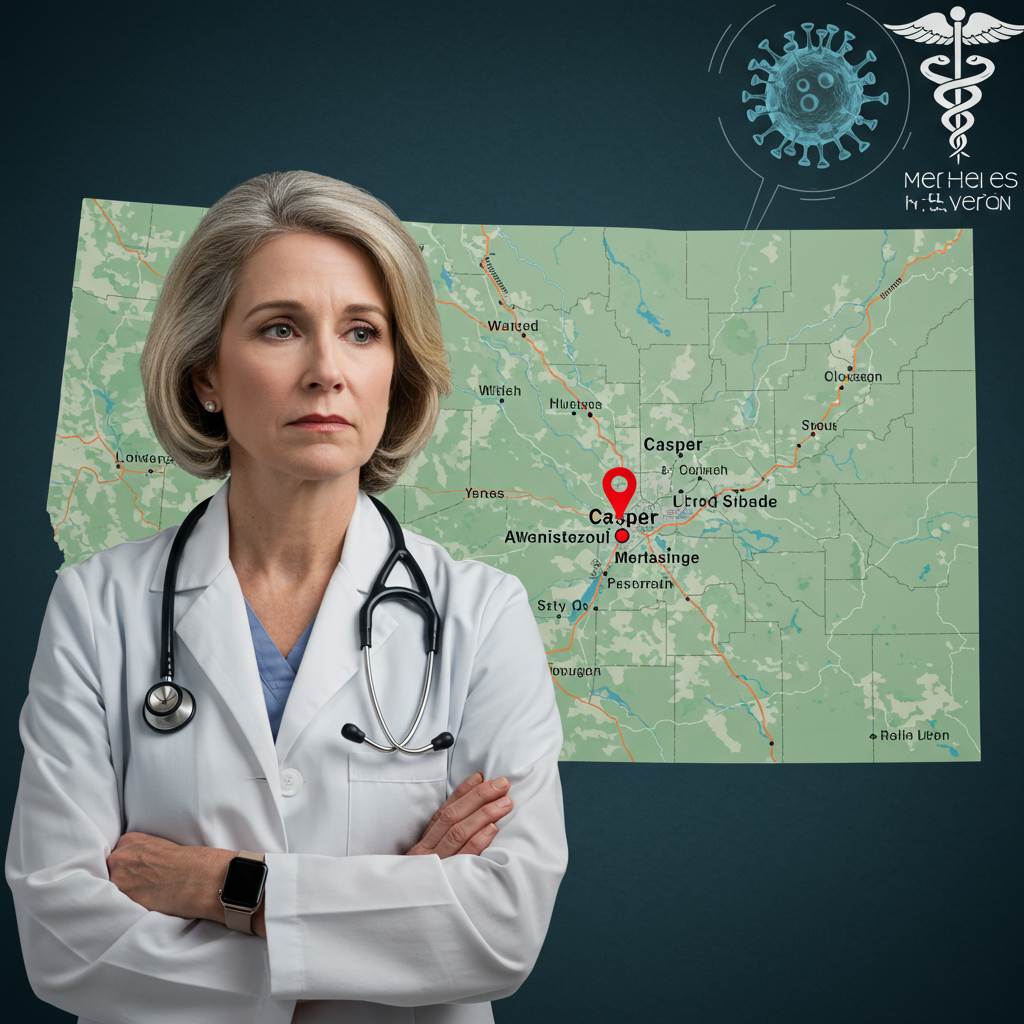A significant public health event has unfolded in Wyoming, marking the state’s first confirmed measles case in 15 years. The Wyoming Department of Health (WDH) announced this week that an unvaccinated child in Natrona County has tested positive for the highly contagious illness. This development ends a remarkable 15-year period during which Wyoming reported no confirmed measles cases, the last being in 2010.
This solitary case emerges amidst a concerning rise in measles outbreaks across the United States and specifically within the Mountain West region. While the source of this particular infection remains under investigation and has not been identified, state health officials are taking proactive steps to prevent any further spread within the community.
Potential Exposure Locations Identified
State health officials have issued a specific public health alert regarding potential exposure locations connected to the confirmed case. The infected child was present in the waiting room of the Emergency Department at Banner Wyoming Medical Center in Casper on two separate occasions while infectious.
The first potential exposure window occurred on Tuesday, June 24, from approximately 11:00 a.m. to 1:00 p.m. The second period of potential exposure was on Wednesday, June 25, from 12:55 p.m. to 2:55 p.m. Individuals who visited the Banner Wyoming Medical Center Emergency Department Waiting Room during these precise times may have been exposed to the measles virus.
WDH and Hospital Response
The Wyoming Department of Health is actively collaborating with Banner Wyoming Medical Center. Their joint effort aims to identify and directly notify individuals who may have been in the waiting room during the specified exposure times. Banner Health has confirmed their cooperation with state and county health departments following the patient’s visit.
The hospital emphasizes its strong commitment to the health and safety of everyone within their facility. This includes staff, patients, and visitors. They are working diligently to minimize any risk of further transmission stemming from this case. This collaborative response is critical in managing the situation effectively.
Guidance for Potentially Exposed Individuals
Dr. Alexia Harrist, who serves as the State Health Officer for the WDH, has provided crucial guidance for anyone who believes they may have been exposed. She strongly recommends self-monitoring for measles symptoms. This monitoring period should last for 21 days following the date of potential exposure.
This 21-day window aligns with the typical incubation period for the measles virus. Symptoms usually begin appearing seven to 21 days after a person is exposed. Vigilance during this time is key to early detection and preventing further spread.
Protecting Others After Potential Exposure
In addition to self-monitoring, Dr. Harrist suggests that individuals potentially exposed take precautions to protect others. This is especially important if they are not vaccinated against measles, mumps, and rubella (MMR). Consider temporarily avoiding crowded public places.
Avoiding high-risk settings is particularly important. Places like daycare centers pose a higher risk environment. Taking these steps can help prevent potential transmission to vulnerable populations should symptoms develop.
Understanding Measles: A Highly Contagious Threat
Measles is recognized as one of the most contagious diseases known. The Centers for Disease Control and Prevention (CDC) estimates its high transmissibility. Roughly 9 out of 10 susceptible individuals in close contact with an infected person will contract the virus. This high rate underscores why controlling outbreaks is so challenging.
The infection can lead to severe illness. While symptoms can vary, they typically follow a predictable pattern. Initial symptoms often include fever, coughing, a runny nose, and red, watery eyes.
Measles Symptoms and Complications
These initial symptoms usually appear about one to two weeks after exposure to the virus. A characteristic measles rash develops several days later. This rash often starts on the face and then spreads downwards across the rest of the body.
Measles is not just a simple rash. It can cause serious health complications. These are particularly concerning for young children under the age of 5. Potential complications include pneumonia, encephalitis (brain swelling), and even death. Certain groups are at higher risk for severe disease. These include infants under 1 year old, pregnant women, and individuals with weakened immune systems.
Immunity and the MMR Vaccine
Fortunately, measles is a preventable disease. The Measles, Mumps, and Rubella (MMR) vaccine provides highly effective protection. Two doses of the MMR vaccine offer robust, long-lasting immunity.
According to the WDH, two doses are approximately 97% effective in preventing measles. Even if exposed, receiving the MMR vaccine within 72 hours can potentially prevent infection altogether or significantly reduce the severity of the illness. Individuals born before 1957 are generally considered immune. This is due to presumed widespread exposure to the virus before vaccination became common.
Vaccination Rates and Herd Immunity
Preventing widespread outbreaks relies heavily on community-level immunity. This is known as “herd immunity.” The CDC and World Health Organization (WHO) recommend a vaccination rate of around 95% for measles to achieve effective herd immunity. This threshold protects even those who cannot be vaccinated, such as infants and immunocompromised individuals.
However, recent trends show concerning declines in vaccination rates both nationally and in Wyoming. National rates for school-aged children decreased from 95% in 2019 to 92% in 2023. In Wyoming, the rate for kindergartners receiving the MMR vaccine has fallen. It dropped from 97.5% in the 2012-13 school year to 93.5% in the 2023-24 school year. This puts the state below the recommended 95% threshold.
Importance of Staying Current on Vaccinations
Wyoming does mandate the measles vaccine for attendance at public or private schools and childcare facilities. However, vaccine exemptions have increased since 2020. This recent measles case highlights the vulnerability created by lower vaccination rates. It underscores the critical importance of ensuring everyone eligible is current on their MMR vaccinations.
The WDH strongly recommends that all Wyoming residents check their and their children’s vaccination status. If you are unvaccinated or unsure of your immunity, consult your healthcare provider about getting the MMR vaccine. Booster doses are not typically needed for those who are fully vaccinated with two doses.
What To Do If You Were Potentially Exposed
If you were in the Banner Wyoming Medical Center Emergency Department Waiting Room during the identified times (June 24, 11 a.m. to 1 p.m. or June 25, 12:55 p.m. to 2:55 p.m.), self-monitor for symptoms for 21 days.
Symptoms include fever, cough, runny nose, red eyes, and a rash. If you develop any of these symptoms, it is crucial to contact a healthcare provider immediately by phone. Do not just show up. If you don’t have a regular provider, call an urgent care center or emergency department. Explain your potential measles exposure before you arrive. This vital step helps prevent potentially exposing others in waiting areas. High-risk individuals should contact their provider promptly even without symptoms.
Frequently Asked Questions
What are the common symptoms of measles and how contagious is it?
Measles is extremely contagious. Symptoms typically appear 7 to 21 days after exposure. Initial signs include fever, cough, runny nose, and red eyes. A characteristic rash usually starts on the face several days later and spreads down the body. The virus spreads easily through the air when an infected person coughs or sneezes.
Where was the potential exposure location for the recent Wyoming measles case?
The potential exposure occurred in the Emergency Department Waiting Room at Banner Wyoming Medical Center in Casper. The specific times identified are June 24 from 11:00 a.m. to 1:00 p.m. and June 25 from 12:55 p.m. to 2:55 p.m. Anyone in that waiting room during those exact periods may have been exposed.
Should I get the MMR vaccine if I haven’t already?
Yes, health officials strongly recommend the MMR vaccine for individuals who are not already immune. It is safe and highly effective, providing long-lasting protection against measles, mumps, and rubella. Getting vaccinated protects you and helps contribute to herd immunity, which shields vulnerable community members. Consult your healthcare provider to confirm your vaccination status.
Staying Vigilant in Natrona County
The confirmation of this first measles case in 15 years serves as a critical reminder. Vigilance is essential within the community. Understanding the risks and taking recommended precautions can help limit further spread.
Health officials urge residents to be aware of the symptoms. They also stress the importance of checking vaccination records. Ensuring high vaccination rates remains the best defense against this preventable, yet potentially severe, illness. By staying informed and following public health guidance, Natrona County residents can play a vital role in protecting themselves and others.
Word Count Check: 1011




